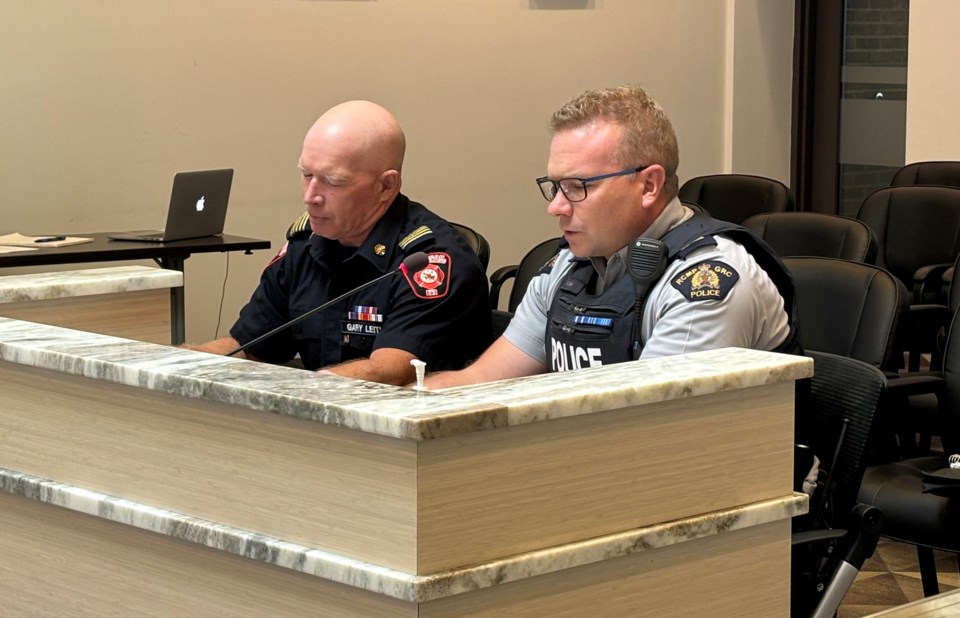INNISFAIL – The calls for service for the local RCMP and fire department have increased dramatically in 2024.
In the summer of 2023, the Mounties received 856 calls. During the same period in 2024 it increased to 1,158, a hike of 35.2 per cent.
And while those stats may reflect increased numbers for suspicious people and vehicles and mischief files – the lower end of severity for complaint cases – Innisfail RCMP Staff Sgt. Ian Ihme told Innisfail town council on Sept. 9 the question arose whether his members were seeing the same trend with homelessness in the community.
“One of the unfortunate things with our stats keeping is we don't actually have a code for tracking specifically homelessness,” Ihme told council during a joint presentation with Gary Leith, Innisfail’s fire chief and manager of fire and protective services, whose department witnessed a 53 per cent increase this year with medical assistance calls.
“Anecdotally, I can say this summer we've definitely seen an increase, but not a large increase,” Ihme told council. “There's been a few individuals in town, probably in the neighbourhood of five to six.”
However, he emphasized that while that number may not be concerning the visibility of homelessness has.
“I think people from town have noticed an increase in visible homelessness, a little bit of disorder that people just are not used to seeing,” Ihme told the Albertan after his council presentation. “And not just that but people posting online a lot more about things they're seeing, things they're observing.
“A lot of them (homeless) are here because they are fleeing communities where they believe they are in danger,” said Ihme, noting their visibility now has more of big city look. “It's more of the stereotypical big city image that we're seeing with some of these people.
“They've got the huge shopping cart with all their belongings, which we see in Red Deer a lot, but typically we haven't seen here,” he added. “We're seeing that little bit more in-your-face visible presence that we haven't necessarily seen before, where it seemed in years past homeless people were a little more discreet.”
Ihme said this group usually does not have long stays in town, weeks maybe but not months. Some, said Ihme, do exhibit anti-social behavior.
“There's a little bit of open drug use that is not normal for this community, and the bigger thing that people end up seeing and reporting ends up being the garbage that's left behind,” said Ihme, adding today’s homelessness will sometimes set up camp in secluded places in town, usually in treed areas.
“We've seen one gentleman actually in a sleeping bag on very uncomfortable rocks at the UFA this morning right in the open, which is not something we normally see,” he said. “He gathered up his stuff and cleaned it all up and moved on his way.”
As for municipal enforcement, Leith told council the issue of today’s homeless and the time spent engaged with them causes issues among multiple town departments, notably for parks and recreation staff when the homeless go into the aquatic centre for showers and where garbage and personal items are left scattered.
“And then it becomes an inhibitor for community members to use them,” said Leith. “Our general tactics have been to move these people to where they can get services. As for writing tickets, it’s not really going to achieve anything for them, even if we write them provincial tickets.”
Following the presentation by Ihme and Leith, Coun. Janice Wing noted the town and council have been talking over the past few years about having a “larger table conversation” about mental health and homelessness, as well as with working with FCSS and coordinating with partner agencies that do come together on a regular basis.
“I just wonder if it's time that we didn't actually be more deliberate about having a conversation,” Wing told council, suggesting the “five or six’ homeless people number Ihme mentioned could be much higher. “We've always experienced the hidden homeless in Innisfail for a long, long time.”
Meghan Jenkins, community services director for the Town of Innisfail, told council that staff is currently working with a consultant on the Community Safety and Well Being Plan, an initiative being driven by the Innisfail Policing & Safe Community Committee.
“It does touch a bit on homelessness and some of our establishments that tend to house the transient population, and how we can look at the actions coming out of that plan,” Jenkins told council.
Jenkins later told the Albertan that many departments are involved with the plan, including FCSS, and that homelessness is not just an enforcement issue but also about “connecting people” with the right supports.
Towards the end of the council discussion on homelessness Ihme noted there were many layers to this issue, such as acute economic challenges people face coupled with lack of housing.
With that, said Ihme, the RCMP and municipal enforcement wind up dealing with individuals challenged with both homelessness and anti-social behaviors.
“These are often people that are causing problems from whatever community they're coming from and now they're fleeing that and coming here,” said Ihme. “And I can't tell you the answer to that because I definitely don't know.”
Mayor Jean Barclay added the town needs to make sure all of the homelessness issue isn't “pulled into the municipal world” because it's the province’s responsibility to deal with much of it and to make sure there is funding.
“So much of this is being downloaded and I see municipalities picking up this in many areas,” said Barclay. “We want to help but at the same time we want to make sure that other levels of government are doing what they're supposed to do too, and to help with this.”



